Global Transformation Pathways
There are 10 Global Transformation Pathway Teams (GTPTs). Each GTPT is comprised of Indigenous scholars and Indigenous Knowledge holders (e.g., Elders), senior/mid-career and early career researchers, as well as graduate students. Our Co-leads will liaise with Indigenous Research Teams carrying out Place-Based Projects (ILPBPs), and work across conventional political, cultural and ecological boundaries to determine how the outputs of ILPBR projects are relevant at global scales.
Core Pathway activities centre around:
- Creating space for networking between Indigenous organizations, governments, and other global partners;
- Supporting the development of methodological toolboxes, webinars, and resources for the ILPBPs;
- Synthesizing research with Indigenous governments and organizations in ways that can amplify results and inform policy and institutional change.
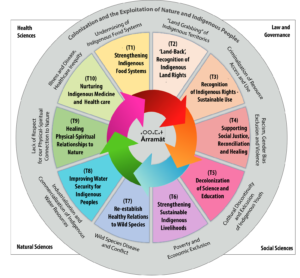
T1 - Strengthening Indigenous Food Systems
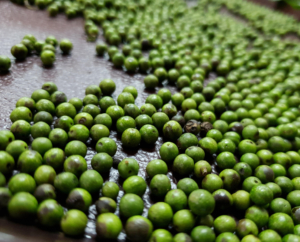
Strengthening Food Security
Relevant and Related Research Gap
Traditional food systems are a well-known determinant of Indigenous health [12]. Biodiversity has been generally described as important to these food systems but specifics are limited [13-15]. What role does biodiversity play in strengthening Indigenous food systems?
Mechanism/Variable in support of Indigenous Health-Well-being
+ – Degree of use of Indigenous foods (proportion of diet); Health/safety and availability of Indigenous food systems
Mechanism/Variable in Support of Biodiversity
+ – use and market/non-market value of biodiversity; improved stewardship due to incentives of food security [16,17]
Example of Interdisciplinary Outputs
Updated/expanded overview of the uses/value of Indigenous foods and medicines (Year 3, Year 6)
T2 - Recognition of Indigenous Land Rights
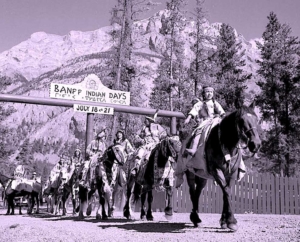
‘Land Back’ – Indigenous Rights
Relevant and Related Research Gap
‘Land grabbing’ has displaced many Indigenous peoples with major health consequences [18–24]; where Indigenous peoples control their lands-resources, biodiversity outcomes improve [25]. How can land-back contribute to biodiversity and Indigenous health-well-being?
Mechanism/Variable in support of Indigenous Health-Well-being
+ – Degree of support/legal recognition of Indigenous territories
Mechanism/Variable in Support of Biodiversity
+ – Security property rights create incentives for sustainable use and opportunities for stewardship [26,27]
+ – Sq. Km area reclaimed/rewilded spaces [28,29]; species recovery (e.g. Indigenous Protected and Conserved Areas) [30]
Example of Interdisciplinary Outputs
Design principles for wholistically re-wilding based on Indigenous Knowledge
T3 - Recognition of Indigenous Rights - Sustainable Use:
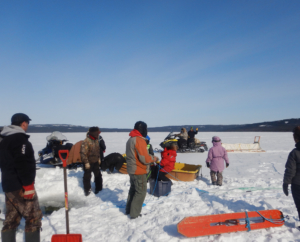
Indigenous Harvesting – Sustainable Use
Relevant and Related Research Gap
The criminalization of Indigenous harvesting and land access has long been a tool of conservation [31-36]. What are the costs of criminalization of subsistence and exclusion of access to valued species, place, health, and wellbeing?
Mechanism/Variable in support of Indigenous Health-Well-being
+ – De-criminalization of harvesting affects strength of country/traditional food systems which are key to positive health outcomes (e.g. decreased malnutrition, chronic illness) [37-40]
Mechanism/Variable in Support of Biodiversity
+ – Recognition of Indigenous harvesting rights and management practices creates incentives and opportunities for improved conservation and sustainable use [41-50]
Example of Interdisciplinary Outputs
Guide/inventory of “problematic” dispositions that contribute to the criminalization of resource access and use
T4 - Supporting Social Justice – Gender Diversity

Social Justice and Reconciliation
Relevant and Related Research Gap
Racism and gender-based violence create barriers to lands-resources, health services. How can social justice policies and recognitions of diverse gender identities improve biodiversity and health-well-being?
Mechanism/Variable in support of Indigenous Health-Well-being
+ – Understanding of the diversity of race/gender identities leads to a decrease in violence and other determinants of poor health [51-53]
Mechanism/Variable in Support of Biodiversity
+ – Natural resource management outcomes including biodiversity conservation improvements with social justice [54-56]
Example of Interdisciplinary Outputs
Indigenous Gender Identities Atlas; Ethnographies of Customary Law
T5 - Decolonization of Science Education
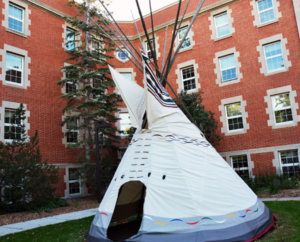
Decolonization of Science and Education
Relevant and Related Research Gap
Colonial education systems have been tools of colonization [57,58]; Present paradigms of biodiversity conservation exclude Indigenous peoples [59]; How can the inclusion of IK in fields of STEM improve approaches to biodiversity and health [60-62]?
Mechanism/Variable in support of Indigenous Health-Well-being
+ – Culturally appropriate and decolonized education opportunities lead to strengthened cultural continuity and are a determinant of improved health and well-being [63-66]
Mechanism/Variable in Support of Biodiversity
+ – Decolonization of STEM, the inclusion of Indigenous Knowledge contributes to a broader and deeper understanding of threats and solutions to biodiversity loss [67-73]
Example of Interdisciplinary Outputs
Indigenous Youth engagement in STEM training; Youth-Action on Biodiversity Health; Networking
T6 - Strengthening Sustainable Indigenous Economies and Livelihoods
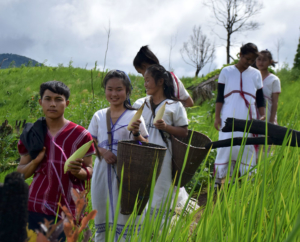
Strengthening Indigenous Livelihoods
Relevant and Related Research Gap
Healing, recovery and innovation in Indigenous livelihoods are emerging in Canada and elsewhere [74–77]. What livelihoods and economies support biodiversity and health-wellbeing?
Mechanism/Variable in support of Indigenous Health-Well-being
+ – Sustainable livelihoods are a core determinant of health [78,79]
Mechanism/Variable in Support of Biodiversity
+ – Socio-economic sustainability affects biodiversity conservation outcomes [80-84]
Example of Interdisciplinary Outputs
Design principles for addressing Indigenous sustainable development models
T7 - Re-establish healthy relationships to wild species
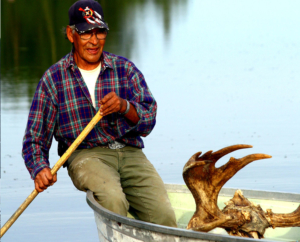
Rebuilding Health Relationships to Wild Species
Relevant and Related Research Gap
There is very limited documented IK about wildlife disease and supporting healthy relationships to wild species and spaces[85-88]. What kinds of insights can be generated about the patterns of disease, their perceived risk? What are some rules/customary laws as well as best/wise practices about tracking (monitoring) and managing the spread of diseases such as COVID-19?
Mechanism/Variable in support of Indigenous Health-Well-being
+ – Recognition of Indigenous Knowledge in management of wild species health, which affects risks to human health [89-93]
Mechanism/Variable in Support of Biodiversity
+ – Recognition of Indigenous Knowledge in Management of wild species affects wildlife and ecosystem health outcomes [94-97]
Example of Interdisciplinary Outputs
Oral histories/observations on wildlife disease patterns; guidebooks for community-based monitoring of wildlife health; principles and management solutions
T8 - Improving water security for Indigenous peoples

Improving Water Security
Relevant and Related Research Gap
Industrialization of water resources is tied to declining aquatic and terrestrial biodiversity [98-100]; significant inequity in access to clean drinking water also exists in Canada and globally; indigenous population density negatively correlates with lower levels of access to water [101-103]. How do Indigenous rights and patterns of access to water affect biodiversity and health outcomes?
Mechanism/Variable in support of Indigenous Health-Well-being
+ – Clean water is a core structural determinant of public health [104]; increased equity in access to, and roles in the management of, water leads to improved health outcomes [105-107]
Mechanism/Variable in Support of Biodiversity
+ – Participatory tracking of threats to water resources > improved management; certainty rights of Indigenous Peoples creates incentives, opportunities for water stewardship and protection of biodiversity [108,109]
Example of Interdisciplinary Outputs
Coordinated community-based monitoring; “Indigenous-State of Aquatic Ecosystems in Canada”
T9 - Healing Physical and Spiritual Relationships to Nature

Healing Physical-Spiritual Relationship to Nature
Relevant and Related Research Gap
Some research recognizes the Current land the spiritual and therapeutic benefits of stewardship to health-well-being. What are the benefits of stewardship of nature to health/well-being? [110-112]. How is “being alive well” [113,114] protective of health and biodiversity?
Mechanism/Variable in support of Indigenous Health-Well-being
+ – Caring for nature (‘country’) and the emotional-spiritual connectedness affects health outcomes (e.g. mental health) [115,116]
Mechanism/Variable in Support of Biodiversity
+ – Emotional and spiritual connectedness to place affects stewardship and conservation outcomes [117-124]
Examples of Interdisciplinary Outputs
Events/storytelling outcomes that demonstrate spiritual intrinsic links existing between Indigenous Peoples and biodiversity/Mother Earth
T10 - Nurturing of Indigenous Approaches to Healing and Medicines

Nurturing Indigenous Medicine and Healthcare
Relevant and Related Research Gap
There is some growing recognition of Indigenous Knowledge related to medicine and health care [125-134]. How can incentives to nurture biodiversity improve health care and health outcomes? What synergies lie in healing people, healing the spirit, and healing the land?
Mechanism/Variable in support of Indigenous Health-Well-being
+ – Access, cultivation, harvest, use, biodiversity in health care, and healing affects efficacy (and cost) of care and health outcomes (e.g. prevention/prevalence of disease) [135-140]
Mechanism/Variable in Support of Biodiversity
+ – Recognition of biodiversity as a source of health, healing, and care affects value (market/non-market) and incentives to nurture biodiversity including genetic biodiversity (e.g. plants) [141-145]
Example of Interdisciplinary Outputs
Evidence of value/efficacy of Traditional Medicines and Health Practices; Wholistic Health Ethnographies
References
[1] Souleymane Ag Anara Tuareg Women, One Using a Traditional Drum Called “Tende,” Which Is Also Used to Ground Cereals (Photo).; Mali, No Date.
[2] Hankivsky, O.; Mussell, L. Gender-Based Analysis plus in Canada: Problems and Possibilities of Integrating Intersectionality. Canadian Public Policy 2018, 44, 303–316.
[3] O’NEIL, J.D.; Reading, J.R.; Leader, A. Changing the Relations of Surveillance: The Development of a Discourse of Resistance in Aboriginal Epidemiology. Human organization 1998, 230–237.
[4] Hyett, S.L.; Gabel, C.; Marjerrison, S.; Schwartz, L. Deficit-Based Indigenous Health Research and the Stereotyping of Indigenous Peoples. Canadian Journal of Bioethics/Revue canadienne de bioéthique 2019, 2, 102–109.
[5] Cameron, E.S. Securing Indigenous Politics: A Critique of the Vulnerability and Adaptation Approach to the Human Dimensions of Climate Change in the Canadian Arctic. Global Environmental Change 2012, 22, 103–114.
[6] McKnight, J. Asset mapping in communities. In Health assets in a global context; Springer, 2010; pp. 59–76.
[7] Silvano, R.A. Fisher in Boat on the Tapajos River, Brazil; 2019.
[8] Alevizou, G.; Alexiou, K.; Zamenopoulos, T. Making Sense of Assets: Community Asset Mapping and Related Approaches for Cultivating Capacities. 2016.
[9] McKnight, J.L.; Kretzmann, J. Mapping Community Capacity; Institute for Policy Research, Northwestern University Evanston, IL, 1996.
[10] Lung-Amam, W.S.; Dawkins, C. The Power of Participatory Story Mapping: Advancing Equitable Development in Disadvantaged Neighbourhoods. Community Development Journal 2020, 55, 473–495.
[11] Talen, E. Bottom-up GIS: A New Tool for Individual and Group Expression in Participatory Planning. Journal of the American Planning Association 2000, 66, 279–294.
[12] Gummer, W.D.; Cash, K.J.; Wrona, F.; Prowse, T.D. The Northern River Basins Study: Context and Design. Journal of Aquatic Ecosystem Stress and Recovery 2000, 8, 7–16.
[13] Garibaldi, A.; Turner, N. Cultural Keystone Species: Implications for Ecological Conservation and Restoration. Ecology and Society: 2004, 9.
[14] Barthel, S.; Crumley, C.; Svedin, U. Bio-Cultural Refugia—Safeguarding Diversity of Practices for Food Security and Biodiversity. Global Environmental Change 2013, 23, 1142–1152.
[15] IUCN Global Species Programme Red List Unit IUCN Red List; http://www.iucnredlist.org/about/contact-info: Cambridge UK, 2017.
[16] Weed, M. “ Meta Interpretation”: A Method for the Interpretive Synthesis of Qualitative Research.; 2005; Vol. 6.
[17] Wollenberg, E.; Merino, L.; Agrawal, A.; Ostrom, E. Fourteen Years of Monitoring Community-Managed Forests: Learning from IFRI’s Experience. International Forestry Review 2007, 9, 670–684.
[18] Environment and Climate Change Canada Species at Risk Public Registry; Government of Canada: Ottawa, 2020.
[19] TallBear, K. Indigenous Bioscientists Constitute Knowledge across Cultures of Expertise and Tradition: An Indigenous Standpoint Research Project. 2014.
[20] TallBear, K. An Indigenous Reflection on Working beyond the Human/Not Human. GLQ: A Journal of Lesbian and Gay Studies 2015, 21, 230–235.
[21] Berkes, F.; Folke, C.; Gadgil, M. Traditional ecological knowledge, biodiversity, resilience and sustainability. In Biodiversity conservation; Springer, 1994; pp. 269–287.
[22] Agrawal, A.; Gibson, C.C. Communities and the Environment: Ethnicity, Gender, and the State in Community-Based Conservation; Rutgers University Press, 2001; ISBN 0-8135-2914-X.
[23] Berkes, F. Community-Based Conservation in a Globalized World. Proceedings of the National academy of sciences 2007, 104, 15188–15193.
[24] Burgess, C.P.; Johnston, F.H.; Berry, H.L.; McDonnell, J.; Yibarbuk, D.; Gunabarra, C.; Mileran, A.; Bailie, R.S. Healthy Country, Healthy People: The Relationship between Indigenous Health Status and “Caring for Country.” Medical Journal of Australia 2009, 190, 567–572.
[25] Khetan, A.K. COVID-19: Why Declining Biodiversity Puts Us at Greater Risk for Emerging Infectious Diseases, and What We Can Do. Journal of General Internal Medicine 2020, 1–2.
[26] Aguilar, G. IUCN Director General’s Statement on International Day of the World’s Indigenous Peoples 2019 2019.
[27] Becker, C.D.; Ostrom, E. Human Ecology and Resource Sustainability: The Importance of Institutional Diversity. Annual review of ecology and systematics 1995, 26, 113–133.
[28] Corlett, R.T. Restoration, Reintroduction, and Rewilding in a Changing World. Trends in ecology & evolution 2016, 31, 453–462.
[29] Naveh, Z. Ecological and Cultural Landscape Restoration and the Cultural Evolution towards a Post-Industrial Symbiosis between Human Society and Nature. Restoration Energy 6: 135–143. In Transdisciplinary challenges in landscape ecology and restoration ecology; Springer, 2007; pp. 281–295.
[30] Zurba, M.; Beazley, K.F.; English, E.; Buchmann-Duck, J. Indigenous Protected and Conserved Areas (IPCAs), Aichi Target 11 and Canada’s Pathway to Target 1: Focusing Conservation on Reconciliation. Land 2019, 8, 10.
[31] Alcorn, J.B. Indigenous Peoples and Conservation. Conservation biology 1993, 7, 424–426.
[32] Colchester, M. Conservation Policy and Indigenous Peoples. Environmental Science & Policy 2004, 7, 145–153.
[33] Mignone, J.; Bartlett, J.; O’Neil, J.; Orchard, T. Best Practices in Intercultural Health: Five Case Studies in Latin America. Journal of ethnobiology and ethnomedicine 2007, 3, 1–11.
[34] Chandler, M.J.; Lalonde, C. Cultural Continuity as a Hedge against Suicide in Canada’s First Nations. Transcultural psychiatry 1998, 35, 191–219.
[35] Egeland, G.M.; Harrison, G.G. Health Disparities: Promoting Indigenous Peoples’ Health through Traditional Food Systems and Self-Determination. Indigenous peoples’ food systems and well-being: interventions and policies for healthy communities 2013, 9–22.
[36] Greenwood, M.; De Leeuw, S.; Lindsay, N.M. Determinants of Indigenous Peoples’ Health: Beyond the Social; Canadian Scholars, 2018; ISBN 1-77338-037-0.
[37] Grant, C.C.; Wall, C.R.; Yates, R.; Crengle, S. Nutrition and Indigenous Health in New Zealand. Journal of paediatrics and child health 2010, 46, 479–482.
[38] Pedersen, J.; Benjaminsen, T.A. One Leg or Two? Food Security and Pastoralism in the Northern Sahel. Human Ecology 2008, 36, 43–57.
[39] Kuhnlein, H. Biodiversity and Sustainability of Indigenous Peoples’ Foods and Diets.; Food and Agriculture Organization of the United Nations (FAO), 2012; pp. 118–125.
[40] Kuhnlein, H.V. Gender Roles, Food System Biodiversity, and Food Security in Indigenous Peoples’ Communities. Maternal & child nutrition 2017, 13, e12529.
[41] Chapin III, F.S.; Zavaleta, E.S.; Eviner, V.T.; Naylor, R.L.; Vitousek, P.M.; Reynolds, H.L.; Hooper, D.U.; Lavorel, S.; Sala, O.E.; Hobbie, S.E.; et al. Consequences of Changing Biodiversity. Nature 2000, 405, 234–242, doi:10.1038/35012241.
[42] Montenegro, R.A.; Stephens, C. Indigenous Health in Latin America and the Caribbean. The Lancet 2006, 367, 1859–1869.
[43] Klein, J.T. Prospects for Transdisciplinarity. Futures 2004, 36, 515–526.
[44] Apgar, J.M.; Argumedo, A.; Allen, W. Building Transdisciplinarity for Managing Complexity: Lessons from Indigenous Practice. International Journal of Interdisciplinary Social Sciences 2009, 4, 255–270.
[45] Cole, A. Towards an Indigenous Transdisciplinarity. Transdisciplinary Journal of Engineering & Science 2017, 8.
[46] Knapp, C.N.; Reid, R.S.; Fernández-Giménez, M.E.; Klein, J.A.; Galvin, K.A. Placing Transdisciplinarity in Context: A Review of Approaches to Connect Scholars, Society and Action. Sustainability 2019, 11, 4899.
[47] McKnight, J. Asset mapping in communities. In Health assets in a global context; Springer, 2010; pp. 59–76.
[48] Alevizou, G.; Alexiou, K.; Zamenopoulos, T. Making Sense of Assets: Community Asset Mapping and Related Approaches for Cultivating Capacities. 2016.
[49] McKnight, J.L.; Kretzmann, J. Mapping Community Capacity; Institute for Policy Research, Northwestern University Evanston, IL, 1996.
[50] Lung-Amam, W.S.; Dawkins, C. The Power of Participatory Story Mapping: Advancing Equitable Development in Disadvantaged Neighbourhoods. Community Development Journal 2020, 55, 473–495.
[51] King, M.; Smith, A.; Gracey, M. Indigenous Health Part 2: The Underlying Causes of the Health Gap. The lancet 2009, 374, 76–85.
[52] Came, H.; Griffith, D. Tackling Racism as a “Wicked” Public Health Problem: Enabling Allies in Anti-Racism Praxis. Social Science & Medicine 2018, 199, 181–188.
[53] Mulé, N.J.; Ross, L.E.; Deeprose, B.; Jackson, B.E.; Daley, A.; Travers, A.; Moore, D. Promoting LGBT Health and Wellbeing through Inclusive Policy Development. International journal for equity in health 2009, 8, 1–11.
[54] Agrawal, A.; Gibson, C.C. Communities and the Environment: Ethnicity, Gender, and the State in Community-Based Conservation; Rutgers University Press, 2001; ISBN 0-8135-2914-X.
[55] Kuhnlein, H.V. Gender Roles, Food System Biodiversity, and Food Security in Indigenous Peoples’ Communities. Maternal & child nutrition 2017, 13, e12529.
[56] Mikkelsen, C. Indigenous Peoples, Gender, and Natural Resource Management; DIIS working paper, 2005; ISBN 87-7605-064-5.
[57] Parlee, B.; Berkes, F. Health of the Land, Health of the People: A Case Study on Gwich’in Berry Harvesting in Northern Canada. EcoHealth 2005, 2, 127–137.
[58] Parlee, B.; O’Neil, J. “The Dene Way of Life”: Perspectives on Health from Canada’s North. Journal of Canadian Studies 2007, 41, 112–133.
[59] Panelli, R. Beyond Foodscapes: Considering Geographies of Indigenous Well-Being. Health and Place 2009, 15, 455–465.
[60] Kimmerer, R.W. Braiding Sweetgrass: Indigenous Wisdom, Scientific Knowledge and the Teachings of Plants; Milkweed Editions, 2013; ISBN 1-57131-871-2.
[61] Lerner, H.; Berg, C. A Comparison of Three Holistic Approaches to Health: One Health, EcoHealth, and Planetary Health. Frontiers in veterinary science 2017, 4, 163.
[62] Atlas, R.M. One Health: Its Origins and Future. One Health: the human-animal-environment interfaces in emerging infectious diseases 2012, 1–13.
[63] Truth and Reconciliation Commission of Canada Final Report of the Truth and Reconciliation Commission of Canada: Honouring the Truth, Reconciling for the Future: Summary (Volume I).; James Lorimer Limited, Publisher: Ottawa, 2015.
[64] Wildcat, D.; McDonald, M.; Irbacher-Fox, S.; Coulthard, G. Learning from the Land: Indigenous Land Based Pedagogy and Decolonization. Decolonization, Indigeneity, Education & Society 2014, 3.
[65] Chandler, M.J.; Lalonde, C.E. Cultural Continuity as a Protective Factor against Suicide in First Nations Youth. Horizons 2008, 10, 68–72.
[66] Shankar, J.; Ip, E.; Khalema, E.; Couture, J.; Tan, S.; Zulla, R.T.; Lam, G. Education as a Social Determinant of Health: Issues Facing Indigenous and Visible Minority Students in Postsecondary Education in Western Canada. International journal of environmental research and public health 2013, 10, 3908–3929.
[67] Snively, G. Knowing Home: Braiding Indigenous Science with Western Science, Book 2. 2018.
[68] Tuck, E.; McKenzie, M.; McCoy, K. Land Education: Indigenous, Post-Colonial, and Decolonizing Perspectives on Place and Environmental Education Research. 2014.
[69] Snively, G.; Corisglia, J. Discovering Indigenous Science: Implicatiosn for Science Education. Science Education 2001, 85, 6–34.
[70] Gadgil, M.; Berkes, F.; Folke, C. Indigenous Knowledge for Biodiversity Conservation. Ambio 1993, 151–156.
[71] Boillat, S. Decolonizing ecological knowledge: transdisciplinary ecology, place making and cognitive justice in the Andes. In The Elgar Companion to Geography, Transdisciplinarity and Sustainability; Edward Elgar Publishing, 2020.
[72] Shizha, E. Rethinking and reconstituting indigenous knowledge and voices in the academy in Zimbabwe: A decolonization process. In Indigenous knowledge and learning in Asia/Pacific and Africa; Springer, 2010; pp. 115–129.
[73] Karikó, S. An Interconnected Approach to Biodiversity Education and Stewardship. 2018.
[74] Gibbs, E.P. The Evolution of One Health: A Decade of Progress and Challenges for the Future. Veterinary Record 2014, 174, 85–91.
[75] Zinsstag, J.; Schelling, E.; Waltner-Toews, D.; Tanner, M. From “One Medicine” to “One Health” and Systemic Approaches to Health and Well-Being. Preventive veterinary medicine 2011, 101, 148–156.
[76] Millennium Ecosystem Assessment Ecosystems and Human Well-Being: Synthesis; Island Press: Washington D.C., 2005.
[77] Folke, C.; Pritchard Jr, L.; Berkes, F.; Colding, J.; Svedin, U. The Problem of Fit between Ecosystems and Institutions: Ten Years Later. Ecology and society 2007, 12.
[78] Anderson, I.; Robson, B.; Connolly, M.; Al-Yaman, F.; Bjertness, E.; King, A.; Tynan, M.; Madden, R.; Bang, A.; Coimbra Jr, C.E. Indigenous and Tribal Peoples’ Health (The Lancet–Lowitja Institute Global Collaboration): A Population Study. The Lancet 2016, 388, 131–157.
[79] Gracey, M.; King, M. Indigenous Health Part 1: Determinants and Disease Patterns. The Lancet 2009, 374, 65–75.
[80] Allison, E.H.; Ellis, F. The Livelihoods Approach and Management of Small-Scale Fisheries. Marine policy 2001, 25, 377–388.
[81] Brooks, J.S. Design Features and Project Age Contribute to Joint Success in Social, Ecological, and Economic Outcomes of Community‐based Conservation Projects. Conservation Letters 2017, 10, 23–32.
[82] Ruiz-Mallén, I.; Schunko, C.; Corbera, E.; Rös, M.; Reyes-García, V. Meanings, Drivers, and Motivations for Community-Based Conservation in Latin America. Ecology and Society 2015, 20.
[83] Agrawal, A.; Redford, K.H. Poverty, Development, and Biodiversity Conservation: Shooting in the Dark?; Wildlife Conservation Society New York, 2006.
[84] Miller, J.R.; Hobbs, R.J. Conservation Where People Live and Work. Conservation biology 2002, 16, 330–337.
[85] Borrows, J. Indigenous Legal Traditions in Canada. Wash. UJL & Pol’y 2005, 19, 167
[86] Tobin, B. Indigenous Peoples, Customary Law and Human Rights-Why Living Law Matters; Routledge, 2014; ISBN 1-317-69754-5.
[87] Kuhnlein, H.; Erasmus, B.; Spigelski, D. Indigenous Peoples’ Food Systems: The Many Dimensions of Culture, Diversity and Environment for Nutrition and Health; Food and Agriculture Organization of the United Nations Centre for Indigenous Peoples’ Nutrition and Environment: Rome, 2009.
[88] Johns, T.; Eyzaguirre, P.B. Linking Biodiversity, Diet and Health in Policy and Practice. Proceedings of the nutrition society 2006, 65, 182–189.
[89] Vandebroek, I.; Pieroni, A.; Stepp, J.R.; Hanazaki, N.; Ladio, A.; Alves, R.R.N.; Picking, D.; Delgoda, R.; Maroyi, A.; van Andel, T. Reshaping the Future of Ethnobiology Research after the COVID-19 Pandemic. Nature Plants 2020, 6, 723–730.
[90] Evans, T.; Olson, S.; Watson, J.; Gruetzmacher, K.; Pruvot, M.; Jupiter, S.; Wang, S.; Clements, T.; Jung, K. Links between Ecological Integrity, Emerging Infectious Diseases Originating from Wildlife, and Other Aspects of Human Health-an Overview of the Literature. World Conservation Society, New York, USA 2020.
[91] Kutz, S.; Veitch, A.; Branigan, M.; Lambert, C.; Wright, W.; Elkin, B.; Bayha, J.; Guthrie, G.; Northwest Territories Cumulative Impact Monitoring, P. Using Hunter Observations and Ecological Knowledge Together with Science to Understand Past and Current Occurrence of Wildlife Diseases in the North: Project Report, March 31, 2005; 2005.
[92] Roe, D.; Dickman, A.; Kock, R.; Milner-Gulland, E.; Rihoy, E. Beyond Banning Wildlife Trade: COVID-19, Conservation and Development. World Development 2020, 136, 105121.
[93] Olaopa, O.R. Harnessing African Indigenous Knowledge for Managing the COVID-19 Pandemic in Africa. International Journal of Technological Learning, Innovation and Development 2020, 12, 267–290.
[94] Khetan, A.K. COVID-19: Why Declining Biodiversity Puts Us at Greater Risk for Emerging Infectious Diseases, and What We Can Do. Journal of General Internal Medicine 2020, 1–2.
[95] Kutz, S.; Tomaselli, M. “Two-Eyed Seeing” Supports Wildlife Health. Science 2019, 364, 1135–1137.
[96] Toledo, V.M. Indigenous Peoples and Biodiversity. Encyclopedia of biodiversity 2001, 3, 451–463.
[97] Jacob, M.O.; Farah, K.O.; Ekaya, W.N. Indigenous Knowledge: The Basis of the Maasai Ethnoveterinary Diagnostic Skills. Journal of Human Ecology 2004, 16, 43–48.
[98] Hirsch, T. Global Biodiversity Outlook 3.; United Nations Environment Program: Bonn, Germany, 2011.
[99] Johns, T.; Powell, B.; Maundu, P.; Eyzaguirre, P.B. Agricultural Biodiversity as a Link between Traditional Food Systems and Contemporary Development, Social Integrity and Ecological Health. Journal of the Science of Food and Agriculture 2013, 93, 3433–3442.
[100] Borras Jr, S.M.; Hall, R.; Scoones, I.; White, B.; Wolford, W. Towards a Better Understanding of Global Land Grabbing: An Editorial Introduction. The Journal of Peasant Studies 2011, 38, 209–216.
[101] Stevenson, S.M. Indigenous Land Rights and the Declaration on the Right of Indigenous Peoples: Implications for Maori Land Claims in New Zealand. Fordham Int’l LJ 2008, 32, 298.
[102] Hanna, P.; Vanclay, F. Human Rights, Indigenous Peoples and the Concept of Free, Prior and Informed Consent. Impact Assessment and Project Appraisal 2013, 31, 146–157.
[103] Feiring, B. Indigenous Peoples’ Rights to Lands, Territories and Resources. International Land Coalition, Rome 2013, 94.
[104] Reading, C.; Greenwood, M. Structural Determinants of Aboriginal Peoples’ Health. Determinants of Indigenous Peoples’ health: Beyond the social 2015, 3–15.
[105] Greenwood, M.; De Leeuw, S.; Lindsay, N.M. Determinants of Indigenous Peoples’ Health: Beyond the Social; Canadian Scholars, 2018; ISBN 1-77338-037-0.
[106] Berry, K.A.; Jackson, S.; Saito, L.; Forline, L. Reconceptualising Water Quality Governance to Incorporate Knowledge and Values: Case Studies from Australian and Brazilian Indigenous Communities. 2018.
[107] Bradford, L.E.; Bharadwaj, L.A.; Okpalauwaekwe, U.; Waldner, C.L. Drinking Water Quality in Indigenous Communities in Canada and Health Outcomes: A Scoping Review. International Journal of Circumpolar Health 2016, 75, 32336.
[108] Matsui, K. Water Ethics for First Nations and Biodiversity in Western Canada. International Indigenous Policy Journal 2012, 3.
[109] Wilson, N.J.; Harris, L.M.; Joseph-Rear, A.; Beaumont, J.; Satterfield, T. Water Is Medicine: Reimagining Water Security through Tr’ondëk Hwëch’in Relationships to Treated and Traditional Water Sources in Yukon, Canada. Water 2019, 11, 624.
[110] Kirmayer, L.; Dandeneau, S.; Marshall, E.; Phillips, M.; Williamson, K. Rethinking Resilience from Indigenous Perspectives. Canadian Journal of Psychiatry 2011, 56, 84–91.
[111] Colchester, M.; MacKay, F.; Griffiths, T.; Nelson, J. A Survey of Indigenous Land Tenure: A Report for the Land Tenure Service of the FAO. 2001.
[112] Cabello, J.; Gilbertson, T. A Colonial Mechanism to Enclose Lands: A Critical Review of Two REDD+-Focused Special Issues. Ephemera: Theory & Politics in Organization 2012, 12.
[113] Tollefson, J. One Million Species Face Extinction. Nature 2019, 9.
[114] Mollett, S. The Power to Plunder: Rethinking Land Grabbing in Latin America. Antipode 2016, 48, 412–432.
[115] Berry, H.L.; Butler, J.R.; Burgess, C.P.; King, U.G.; Tsey, K.; Cadet-James, Y.L.; Rigby, C.W.; Raphael, B. Mind, Body, Spirit: Co-Benefits for Mental Health from Climate Change Adaptation and Caring for Country in Remote Aboriginal Australian Communities. New South Wales Public Health Bulletin 2010, 21, 139–145.
[116] Burgess, C.P.; Johnston, F.H.; Berry, H.L.; McDonnell, J.; Yibarbuk, D.; Gunabarra, C.; Mileran, A.; Bailie, R.S. Healthy Country, Healthy People: The Relationship between Indigenous Health Status and “Caring for Country.” Medical journal of Australia 2009, 190, 567–572.
[117] Buta, N.; Holland, S.M.; Kaplanidou, K. Local Communities and Protected Areas: The Mediating Role of Place Attachment for pro-Environmental Civic Engagement. Journal of Outdoor Recreation and Tourism 2014, 5, 1–10.
[118] Parlee, B.; Lutsel K’e Dene First Nation Understanding and Communicating about Ecological Change. In Breaking Ice: Renewable Resource and Ocean Management in the Canadian North; Berkes, F., Diduck, A., Manseau, M., Eds.; University of Calgary Press: Calgary, 2005; p. 165.
[119] Loring, P.A.; Hinzman, M.S.; Neufeld, H. Can People Be Sentinels of Sustainability? Identifying the Linkages among Ecosystem Health and Human Well-Being. Facets 2016, 1, 148–162.
[120] Simaika, J.P.; Samways, M.J. Biophilia as a Universal Ethic for Conserving Biodiversity. Conservation Biology 2010, 24, 903–906.
[121] Ntiamoa-Baidu, Y. Indigenous Beliefs and Biodiversity Conservation: The Effectiveness of Sacred Groves, Taboos and Totems in Ghana for Habitat and Species Conservation. Journal for the Study of Religion, Nature & Culture 2008, 2.
[122] Irvine, K.N.; Hoesly, D.; Bell-Williams, R.; Warber, S.L. Biodiversity and spiritual well-being. In Biodiversity and Health in the Face of Climate Change; Springer, Cham, 2019; pp. 213–247.
[123] Reynolds, T.; Sisay, T.S.; Wassie, A.; Lowman, M. Sacred Natural Sites Provide Ecological Libraries for Landscape Restoration and Institutional Models for Biodiversity Conservation. GSDR Brief 2015.
[124] Salick, J.; Amend, A.; Anderson, D.; Hoffmeister, K.; Gunn, B.; Zhendong, F. Tibetan Sacred Sites Conserve Old Growth Trees and Cover in the Eastern Himalayas. Biodiversity and Conservation 2007, 16, 693–706.
[125] Gilbert, J. Land Grabbing, Investors, and Indigenous Peoples: New Legal Strategies for an Old Practice? Community Development Journal 2016, 51, 350–366.
[126] Pieratos, N.A.; Manning, S.S.; Tilsen, N. Land Back: A Meta Narrative to Help Indigenous People Show up as Movement Leaders. Leadership 2020, 1742715020976204.
[127] Zaninka, P. The Impact of (Forest) Nature Conservation on Indigenous Peoples; the Batwa of South-Western Uganda: A Case Study of the Mgahinga and Bwindi Impenetrable Forest Conservation Trust. Forest Peoples Programme 2001, 165–194.
[128] Domínguez, L.; Luoma, C. Decolonising Conservation Policy: How Colonial Land and Conservation Ideologies Persist and Perpetuate Indigenous Injustices at the Expense of the Environment. Land 2020, 9, 65.
[129] Chaudhury, A.; Colla, S. Next Steps in Dismantling Discrimination: Lessons from Ecology and Conservation Science. Conservation Letters 2020, e12774.
[130] Antunes, A.P.; Rebêlo, G.H.; Pezzuti, J.C.B.; de Mattos Vieira, M.A.R.; Constantino, P. de A.L.; Campos-Silva, J.V.; Fonseca, R.; Durigan, C.C.; Ramos, R.M.; do Amaral, J.V. A Conspiracy of Silence: Subsistence Hunting Rights in the Brazilian Amazon. Land Use Policy 2019, 84, 1–11.
[131] Truth and Reconciliation Commission of Canada Final Report of the Truth and Reconciliation Commission of Canada: Honouring the Truth, Reconciling for the Future: Summary (Volume I).; James Lorimer Limited, Publisher: Ottawa, 2015.
[132] Battiste, M. You Can’t Be the Global Doctor If You’re the Colonial Disease. Teaching as activism 2005, 121–133.
[133] Kuokkanen, R. Reshaping the University: Responsibility, Indigenous Epistemes, and the Logic of the Gift; ubc Press, 2011; ISBN 0-7748-4084-6.
[134] Stonechild, B. The New Buffalo: The Struggle for Aboriginal Post-Secondary Education; Univ. of Manitoba Press, 2006; ISBN 0-88755-377-X.
[135] Mignone, J.; Bartlett, J.; O’Neil, J.; Orchard, T. Best Practices in Intercultural Health: Five Case Studies in Latin America. Journal of ethnobiology and ethnomedicine 2007, 3, 1–11.
[136] Waldram, J. The Construction of the Mind and Mental Health of North American Aboriginal Peoples; University of Toronto Press.: Toronto, 2004.
[137] Leonti, M. Traditional Medicines and Globalization: Current and Future Perspectives in Ethnopharmacology. Frontiers in pharmacology 2013, 4, 92.
[138] Etkin, N.L. Cultural constructions of efficacy. In The context of medicines in developing countries; Springer, 1988; pp. 299–326.
[139] Gqaleni, N.; Moodley, I.; Kruger, H.; Ntuli, A.; McLeod, H. Traditional and Complementary Medicine: Health Care Delivery. South African health review 2007, 2007, 175–188.
[140] Diallo, D.; Graz, B.; Falquet, J.; Traoré, A.K.; Giani, S.; Mounkoro, P.P.; Berthé, A.; Sacko, M.; Diakité, C. Malaria Treatment in Remote Areas of Mali: Use of Modern and Traditional Medicines, Patient Outcome. Transactions of the Royal Society of Tropical Medicine and Hygiene 2006, 100, 515–520.
[141] Bodeker, G. Traditional Medical Knowledge and Twenty-First Century Healthcare: The Interface between Indigenous and Modern Science. Local Science vs Global Science: Approaches to Indigenous Knowledge in International Development 2007, 23–39.
[142] Bouzabata, A. Biodiversity, Traditional Medicine and Diabetes in North-Eastern Algeria.; Springer, 2017; pp. 1219–1221.
[143] Zhang, X. Traditional Medicine: Its Importance and Protection. Protecting and promoting traditional knowledge: systems, national experiences and international dimensions. Part 2004, 1, 3–6.
[144] Schippmann, U.; Leaman, D.J.; Cunningham, A. Impact of Cultivation and Gathering of Medicinal Plants on Biodiversity: Global Trends and Issues. Biodiversity and the ecosystem approach in agriculture, forestry and fisheries 2002.
[145] McNeely, J.A. Economics and Biological Diversity: Developing and Using Economic Incentives to Conserve Biological Resources; Iucn, 1988; ISBN 2-88032-964-7.

